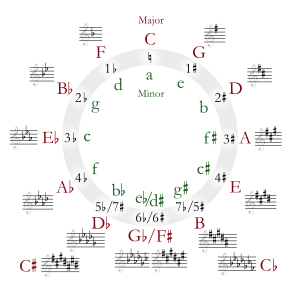D-flat minor facts for kids
 |
||
| Relative key | F♭ major | |
|---|---|---|
| Parallel key | D♭ major | |
| Notes in this scale | ||
| D♭, E♭, F♭, G♭, A♭, B |
||
D-flat minor is a musical idea called a theoretical key. It's based on the note D♭. A key signature tells you which notes to play flat or sharp. This key has seven flats and one double flat! That's a lot of symbols to read.
Because it has so many flats, D♭ minor is usually written in music as its enharmonic equivalent. This means it sounds exactly the same, but it's written differently. The enharmonic equivalent for D♭ minor is [[C♯ minor]]. C♯ minor has only four sharps, which is much easier to read and play.
For example, the famous composer Gustav Mahler used a special musical idea in his Fourth and Fifth Symphonies. In his Symphony No. 4, he wrote this idea in D♭ minor. But when he used the same idea in his Symphony No. 5, he wrote it as C♯ minor. This shows how composers often choose the easier way to write the music.
Another example is in Mahler's Symphony No. 9. A solo bassoon plays a tune that starts in D♭ minor. But later in the same piece, when the tune comes back, it's written as C♯ minor. This helps musicians read the music more easily. The composer Anton Bruckner also did something similar in his Symphony No. 8. Some parts sound like D♭ minor, but they are written as C♯ minor.
Contents
Understanding Musical Keys
Musical keys are like the main "home base" for a song. They tell you which notes fit together to create a certain sound or mood. Minor keys, like D-flat minor, often sound a bit more serious or sad compared to major keys.
What is a Key Signature?
A key signature is a set of sharps or flats placed at the beginning of a piece of music. These symbols tell you to play certain notes higher or lower throughout the song. For example, if a key signature has a flat on the B line, every B note you see will be played as B-flat.
Enharmonic Equivalents Explained
Think of enharmonic equivalents as two different names for the same thing. In music, an enharmonic equivalent means two notes or keys that sound exactly the same but are written differently. For example, C-sharp (C♯) and D-flat (D♭) are enharmonic notes. They are played on the same key on a piano, but they have different names. This is why D-flat minor and C-sharp minor sound the same.
Scales and the Circle of Fifths
A scale is a series of musical notes played in a specific order, usually going up or down. The D-flat minor scale has notes like D-flat, E-flat, F-flat, G-flat, A-flat, B-double flat, and C-flat. It sounds complicated because of all those flats!
The Circle of fifths is a diagram that helps musicians understand how different musical keys are related to each other. It shows how keys with more sharps or flats are connected. Keys that are close on the circle sound good together.
| Diatonic Scales and Keys | |||||||||||||||||||||||||||||||||||||||||||||||||||||||
|---|---|---|---|---|---|---|---|---|---|---|---|---|---|---|---|---|---|---|---|---|---|---|---|---|---|---|---|---|---|---|---|---|---|---|---|---|---|---|---|---|---|---|---|---|---|---|---|---|---|---|---|---|---|---|---|
|
|||||||||||||||||||||||||||||||||||||||||||||||||||||||
| The table shows the number of sharps or flats in each scale. Minor scales are written in lower case. | |||||||||||||||||||||||||||||||||||||||||||||||||||||||


